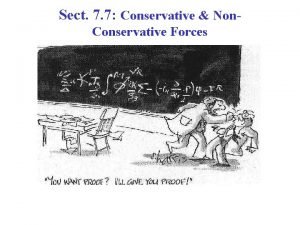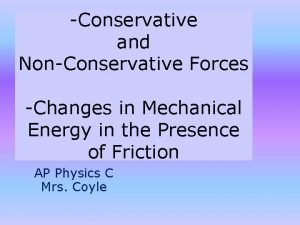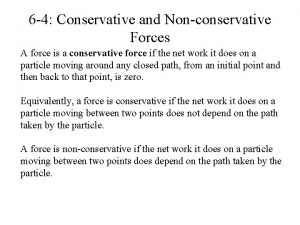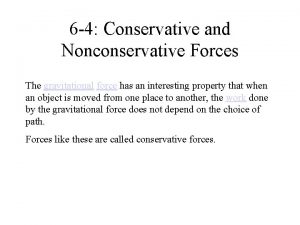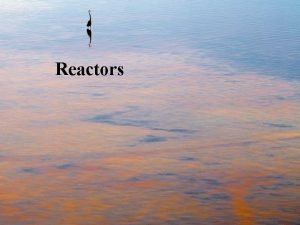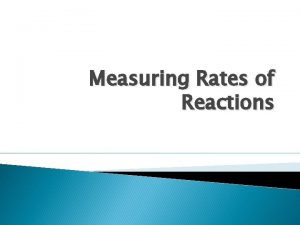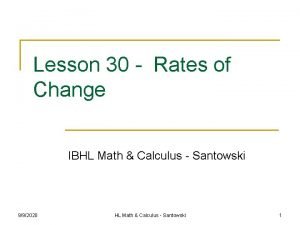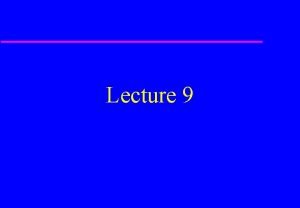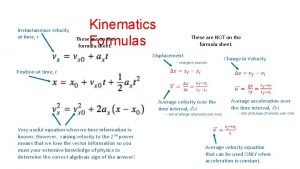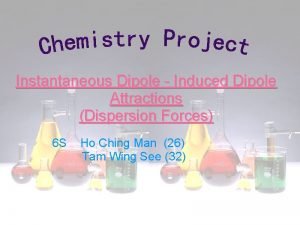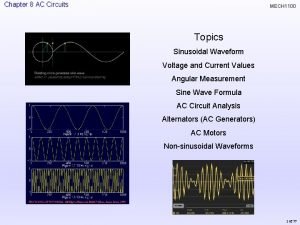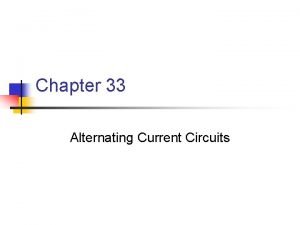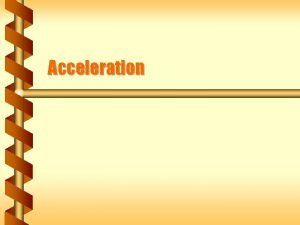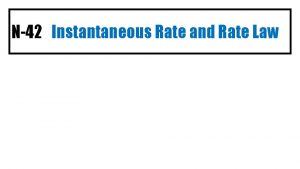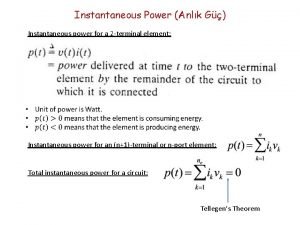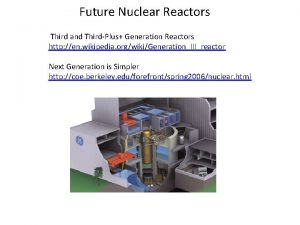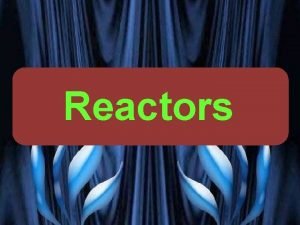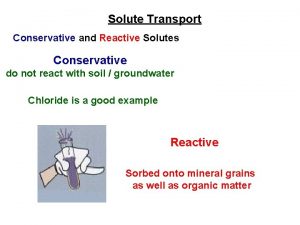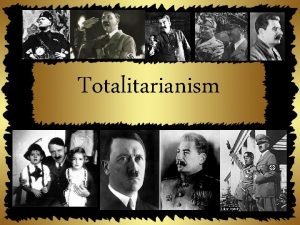Reactors Mixing Model Conservative and Instantaneous Signal A















![By extension: Ci = (C 0/(i – 1)!) [n(t/t 0)]i-1 e-n(t/to) Use this equation By extension: Ci = (C 0/(i – 1)!) [n(t/t 0)]i-1 e-n(t/to) Use this equation](https://slidetodoc.com/presentation_image_h/8130e2268e4a898ab87ccfb10f072c1d/image-16.jpg)



- Slides: 19

Reactors

Mixing Model Conservative and Instantaneous Signal A signal is a tracer that injected into the influent to a reactor Conservative means it does not react Instantaneous means the tracer is introduced into the influent instantaneously

Ideal reactors Mixed Batch Fully mixed, no inflow, no out flow Plug Flow Continuous flow, but no mixing Completely Mixed Flow Reactor Continuous flow with perfect mixing

Mixed Batch Reactor Conservative Instantaneous Signal Added Signal added at time zero, mixed instantaneously This figure is called a C-distribution A plot of C vs t or C/C 0 vs t

Plug Flow Reactor No longitudinal mixing, all elements of water enter and exit in same order. The time spent in the reactor, the residence time, is equal for all elements: t = V/Q V = volume Q = flow rate Another way to think of the residence time is the time to fill the reactor. This is actually true for any type of reactor.

Plug Flow Reactor C-distribution Curve

Plug Flow Reactor F-distribution Curve F is the fraction of that has left the reactor at any time t: F = (A 0 –AR)/A 0 = the mass of tracer added to the reactor AR = the mass of tracer remaining in the reactor

Completely Mixed Flow Reactor Abbreviated CMF. Often called Completely Stirred Tank Reactor (CSTR) or Complete Mix reactor Rate of = Signal + Signal Accumulated in out Generated Signal introduced instantaneously so the rate in = 0 Also, no generation (conservative tracer) Rate of = Signal Accumulated 0 - Rate of Signal out C 0 = A 0/V Where: A 0 = mass of signal in the reactor at t = 0 V = volume of the reactor C 0 = concentration in reactor at t = 0

After the tracer has been introduced (instantaneously) the concentration changes with time because water without tracer keeps entering the reactor and: C = A/V Where: A = mass of tracer in the reactor at any time t V = volume of the reactor C = concentration at time t Now: Rate of = Signal Accumulated out Rate of Signal Accumulated So: = - C Q = -(A/V) Q d. A/dt = -(A/V) Q

d. A/dt = -(A/V) Q A t d. A/A = A 0 Q/V dt 0 ln. A - ln. A 0 = - (Q/V) t A/A 0 = e-(Q/V)t t = V/Q So: A/A 0 = e-t / t Or: C/C 0 = e-t / t

C/C 0 = e-t / t When t = t, : C/C 0 = e-1 = 0. 368

Completely Mixed Flow Reactor F-distribution Curve

CSTR’s in Series N reactors in series Each reactor has a volume of V 0 Total volume of the system, V = n x V 0 The rest of the discussion is section 5. 1. 4 in your text is incorrect. The following derivation is the right way to do it!

Mass balance on the first reactor: (V/n) d. C 1/dt = Q C 0 – Q C 1 Or: d. C 1/dt = (n. Q/V) (C 0 – C 1) Separate variables and integrate: C 1 = C 0 e-n(Q/V)t = C 0 e-n t / to where to = V/Q (residence time of the whole system)

Mass balance on the second reactor: (V/n)d. C 2/dt = Q C 1 - Q C 2 Or: d. C 2/dt + (n. Q/V)C 2 = (n. Q/V) C 1 Since: C 1 = C 0 e-n t / to d. C 2/dt + (n. Q/V)C 2 = (n. Q/V) C 0 e-n t / to The solution to this equation is: C 2 = C 0 n (t / t 0) e-n t / to
![By extension Ci C 0i 1 ntt 0i1 entto Use this equation By extension: Ci = (C 0/(i – 1)!) [n(t/t 0)]i-1 e-n(t/to) Use this equation](https://slidetodoc.com/presentation_image_h/8130e2268e4a898ab87ccfb10f072c1d/image-16.jpg)
By extension: Ci = (C 0/(i – 1)!) [n(t/t 0)]i-1 e-n(t/to) Use this equation to predict concentration coming from any reactor in the series at any time t Or: Ci/C 0 = (1/(i – 1)!) [n(t/t 0)]i-1 e-n(t/to) Use this equation to plot a C-distribution curve Note: These equations are slightly different from the equations in the book. The equations in the book are incorrect. (Equations 5. 2 and 5. 3)

F-distribution curves for a series of CSTR’s may also be Developed. The equation is in your text on page 135. It is correct. The F-distribution for n= infinity is identical to the f-distribution for a plug flow reactor


In the real world there is no such thing as a perfect plug flow reactor or CSTR Causes: Imperfect mixing Short circuiting Dead Space Arbitrary Flow Reactors
 Shunt reactors for power factor correction
Shunt reactors for power factor correction Conservative and non conservative forces
Conservative and non conservative forces Force conservative et non conservative
Force conservative et non conservative Force conservative et non conservative
Force conservative et non conservative Gravitational force is conservative
Gravitational force is conservative Conservative mixing
Conservative mixing Baseband signal and bandpass signal
Baseband signal and bandpass signal Baseband signal and bandpass signal
Baseband signal and bandpass signal Classification of signal
Classification of signal Digital signal as a composite analog signal
Digital signal as a composite analog signal Average rate of change equation
Average rate of change equation How to calculate instantaneous rate of reaction
How to calculate instantaneous rate of reaction 30rates
30rates Velocity example pictures
Velocity example pictures Kinematic equation for instantaneous velocity
Kinematic equation for instantaneous velocity What is instantaneous dipole
What is instantaneous dipole How to find instantaneous velocity
How to find instantaneous velocity Instantaneous voltage formula
Instantaneous voltage formula Instantaneous voltage formula
Instantaneous voltage formula Instantaneous acceleration
Instantaneous acceleration

